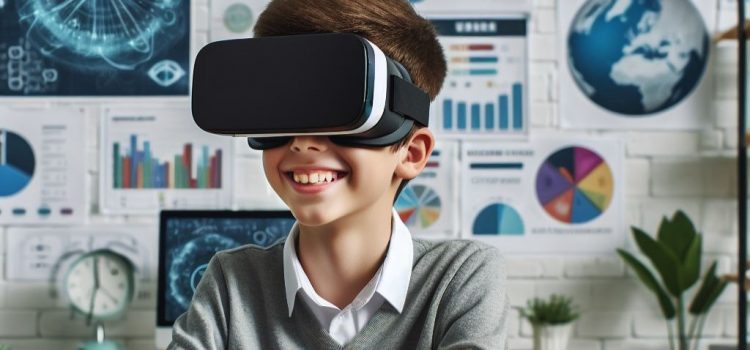
What will virtual and augmented reality be used for in the future? How will entertainment and education improve with VR and AR?
According to Peter H. Diamandis and Steven Kotler, the ways we learn and entertain ourselves will transform dramatically due to exponential technologies. What’s more exciting is that this will be in the not-too-distant future.
Continue reading for future VR and AR applications in entertainment and education.
Expanding Entertainment and Education
The authors argue that entertainment and education will become highly interactive and immersive thanks to VR and AR applications:
- Virtual Reality (VR): VR allows you to insert yourself into a computer generated world and interact with characters and diverse settings as if you’re truly there.
- Augmented Reality (AR): AR melds the digital and physical world. AR glasses and contact lenses will overlay digital images and information onto our actual environment.
(Shortform note: The rise and fall of the Metaverse serves as a cautionary tale of the obstacles that stand between Diamandis and Kotlers’ vision and reality. Initiated by Facebook, the Metaverse aimed to fuse VR, AI, and social media into a virtual universe where people can reside and interact. Zuckerberg had optimistic visions for the Metaverse, even rebranding Facebook as Meta. However, despite high hopes and substantial investment, it failed to gain traction and deliver on its promises, costing the company billions of dollars.)
Interactive Content
Traditional forms of entertainment (like watching TV, for example) are passive: You simply observe what’s in front of you without being directly involved. However, the authors write that in the future, you’ll no longer be a passive observer of content but instead, an active participant.
(Shortform note: New technologies may be making active content more common, but interactive entertainment is by no means new. Choose Your Own Adventure books, for instance, have allowed readers to make decisions that influence the book’s narrative since 1979. Additionally, long before Netflix’s interactive movie Bandersnatch, the 1967 Czech film Kinoautomat allowed its viewers to change the film’s story by voting with red or green buttons.)
Diamandis and Kotler explain that with advances in artificial intelligence, sensors, and VR, content will be able to change based on factors such as your reactions, personality, and so on. Virtual reality sets are already being used in a variety of ways to achieve this—some video games, for instance, change the gameplay based on your heart rate and other physical reactions—and they’re getting even more immersive. Researchers are developing technologies like full body haptic suits to simulate touch as well as scent generators to simulate smell, further blurring the line between audience and content.
(Shortform note: By simulating multiple senses, these suits and devices create an experience called “presence.” Presence is when we feel like we’re truly in a virtual world. It makes us feel more engaged, emotionally involved, and connected to virtual environments. Experts argue that to have presence, you need two things: a sense of self-embodiment (a feeling that you have a body in the virtual world) and physical interaction (when the virtual environment changes based on your actions). Thus, integrating user input like emotional reactions, smell, and touch help VR users to achieve a deeper sense of presence.)
Multisensory Learning
The authors write that in education, VR and AR can help people learn better by providing immersive, interactive, and adaptable experiences, bridging the gap between theory and practice.
First, researchers argue that the multisensory learning that VR and AR can provide is more effective than any other form of learning. Virtual classrooms can put students in immersive teaching environments—allowing them to take history lessons on a Civil War battlefield, for instance. Similarly, an AR-enhanced museum could give students access to multimedia content related to exhibits, allowing them to interact with objects in ways not possible in a traditional museum.
(Shortform note: In Brain Rules, John Medina explains that we learn best when using multiple senses because humans evolved to live in a multisensory world. Our environments are full of different sensory stimuli that occur simultaneously (such as the smell, sound, and feel of rain, for instance), so our brains are naturally designed to make sense of them at the same time. In fact, when we use any of our senses, others are also automatically activated and even enhance one another. For these reasons, we can remember information and solve problems better when we use multiple senses at the same time.)
Second, Diamandis and Kotler write that VR is effective at teaching empathy, which can help students understand difficult topics like homelessness and racism. By simulating experiences and environments, VR allows users to virtually step into someone else’s shoes and experience their realities firsthand, promoting a deeper level of understanding and awareness.
(Shortform note: Like VR, reading fiction can also improve your empathy. Reading simulates experiences and scenarios akin to VR (albeit through your imagination instead of a headset). To follow a fictional story, you must understand different characters’ goals, thoughts, and beliefs. Because of this, research shows that fiction readers are often more adept at understanding what others are thinking and feeling.)






